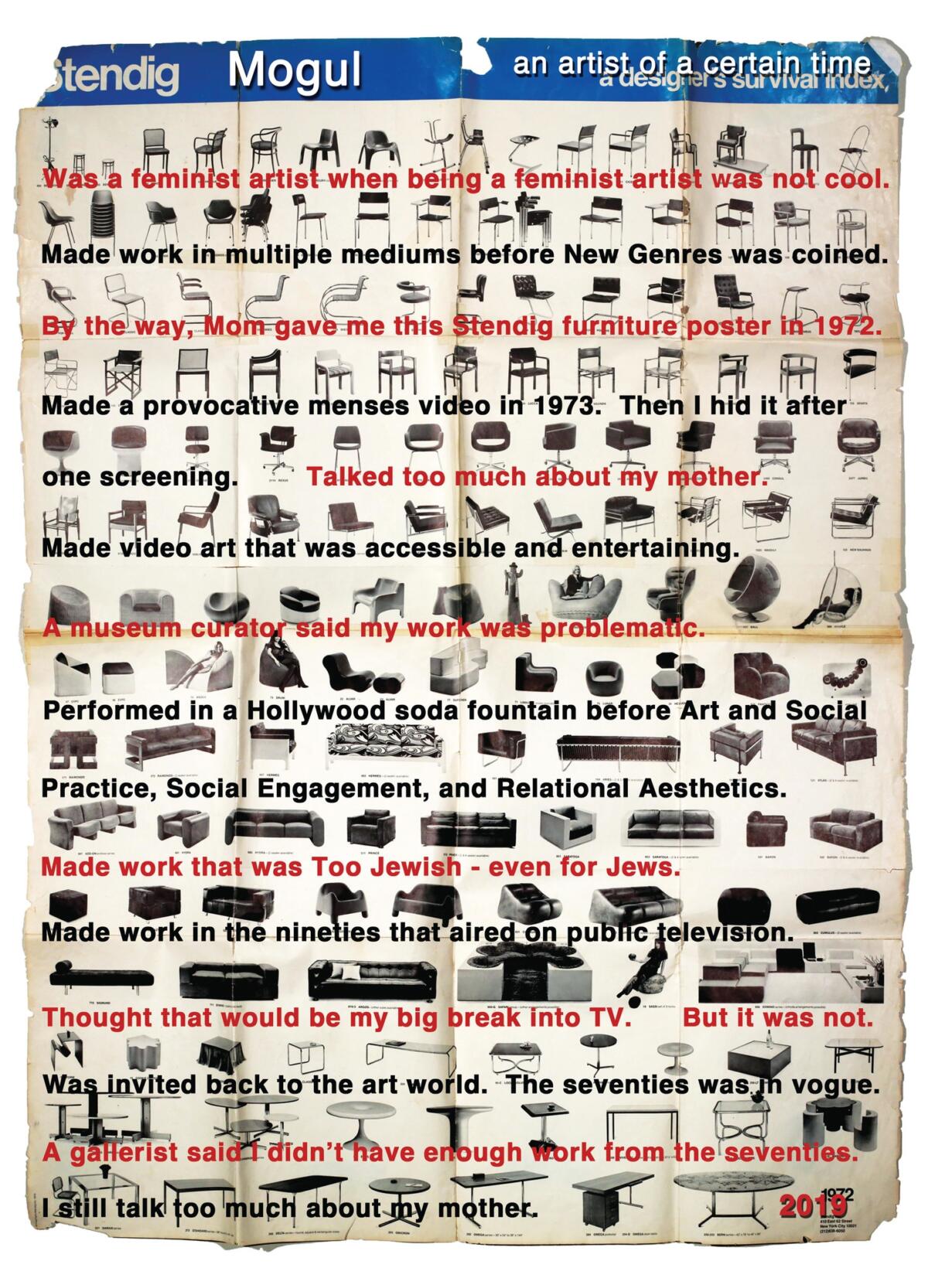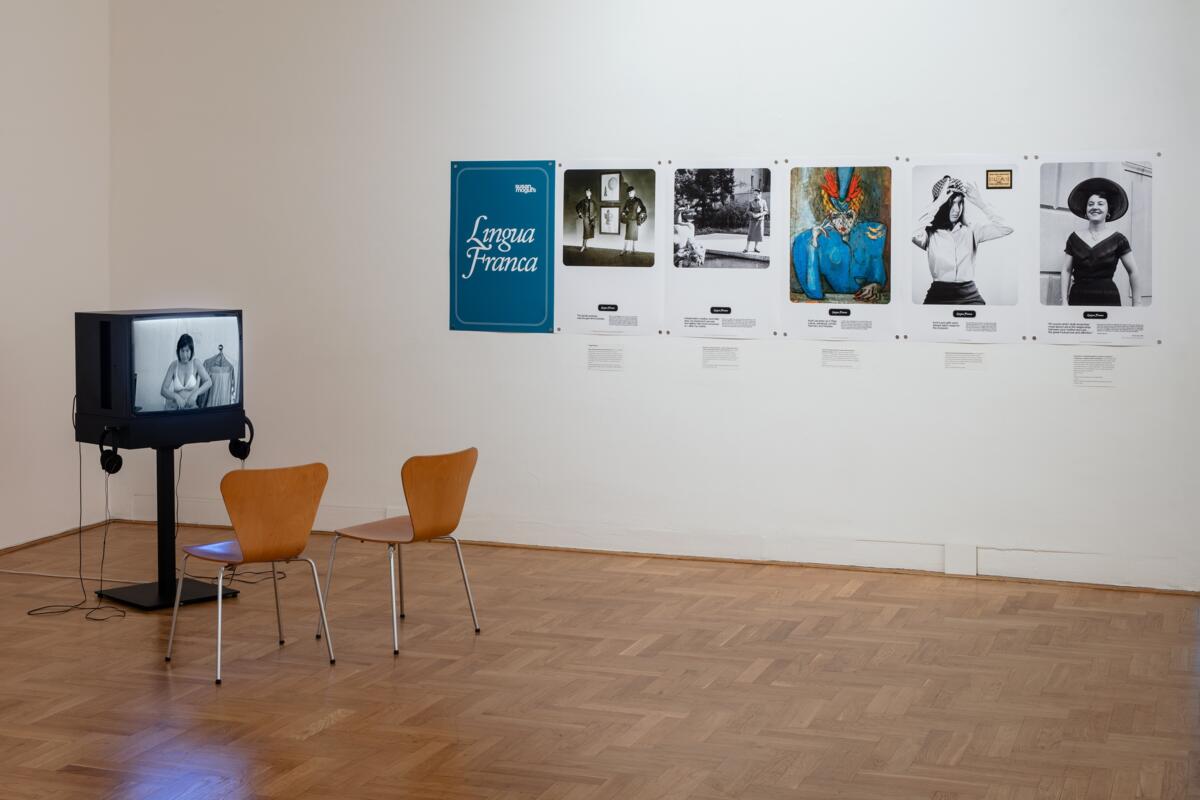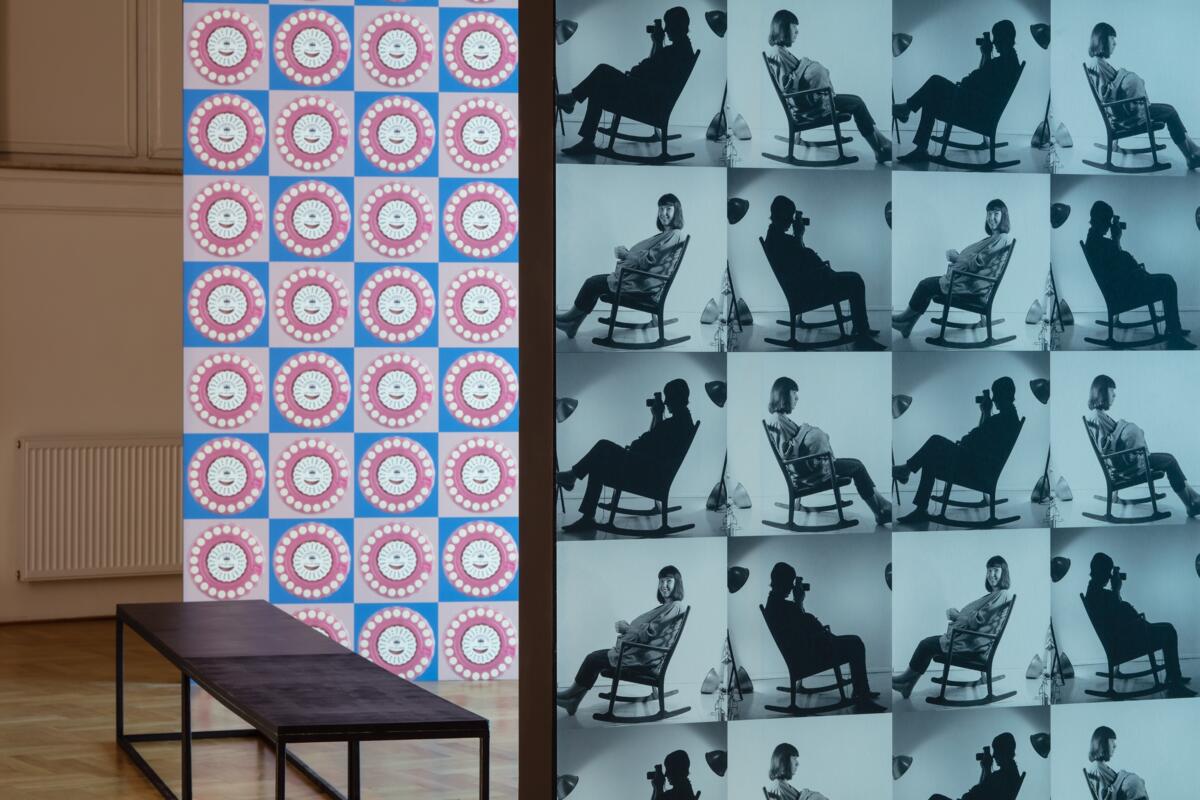
Vera Zalutskaya: Your piece (from which the title of the exhibition is taken) What becomes a Legend most? (2022) has a signature claiming that you are anticipating your first solo museum exhibition. Is it true? Was the exhibition at Zachęta in Warsaw your first solo museum exhibition? And why?
Susan Mogul: Yes it was my first solo museum exhibition. I can’t give you the exact reason, but the artist isn’t the one who decides when they have a solo exhibition. The people in charge of the museum, the gatekeepers, are the ones who make those decisions.
But you decided to play with this fact and make it a part of your practice. I find it interesting.
Well, you know, the signature, “Susan Mogul, the septuagenarian…” means someone who’s in her seventies. That’s very important because in many ways I’m using myself as a stand-in for other women of my generation or older who are getting a solo museum exhibition late in life. I’ve been in many, many group exhibitions in museums but never a solo exhibition. And there are many deserving women artists all over the world who have never had a solo museum exhibition.
I was an early practitioner of video art. My early videotapes included in this exhibition, Dressing Up (1973) and Take Off (1974), got some attention at the time they were made because I was part of the feminist art movement in Los Angeles. But they got attention on a national and an international level twenty years later, when they were presented in numerous historical exhibitions about video art, feminist art, and Los Angeles art. So I made work at one point in time and then the work became more important at a much later date. This is not useful for an artist. You’re pleased about it on one hand, but on the other hand in terms of your career it’s not very helpful. As a result people view you as this woman artist who made work in the seventies. In the 2000s I was introduced to an art historian at a party and she responded: “Oh! Susan Mogul! Susan Mogul from the seventies”. That really happened. And, when I got my first solo commercial gallery exhibition in 2009, the gallery director only wanted to show my work from the seventies, he wouldn’t even look at anything else.
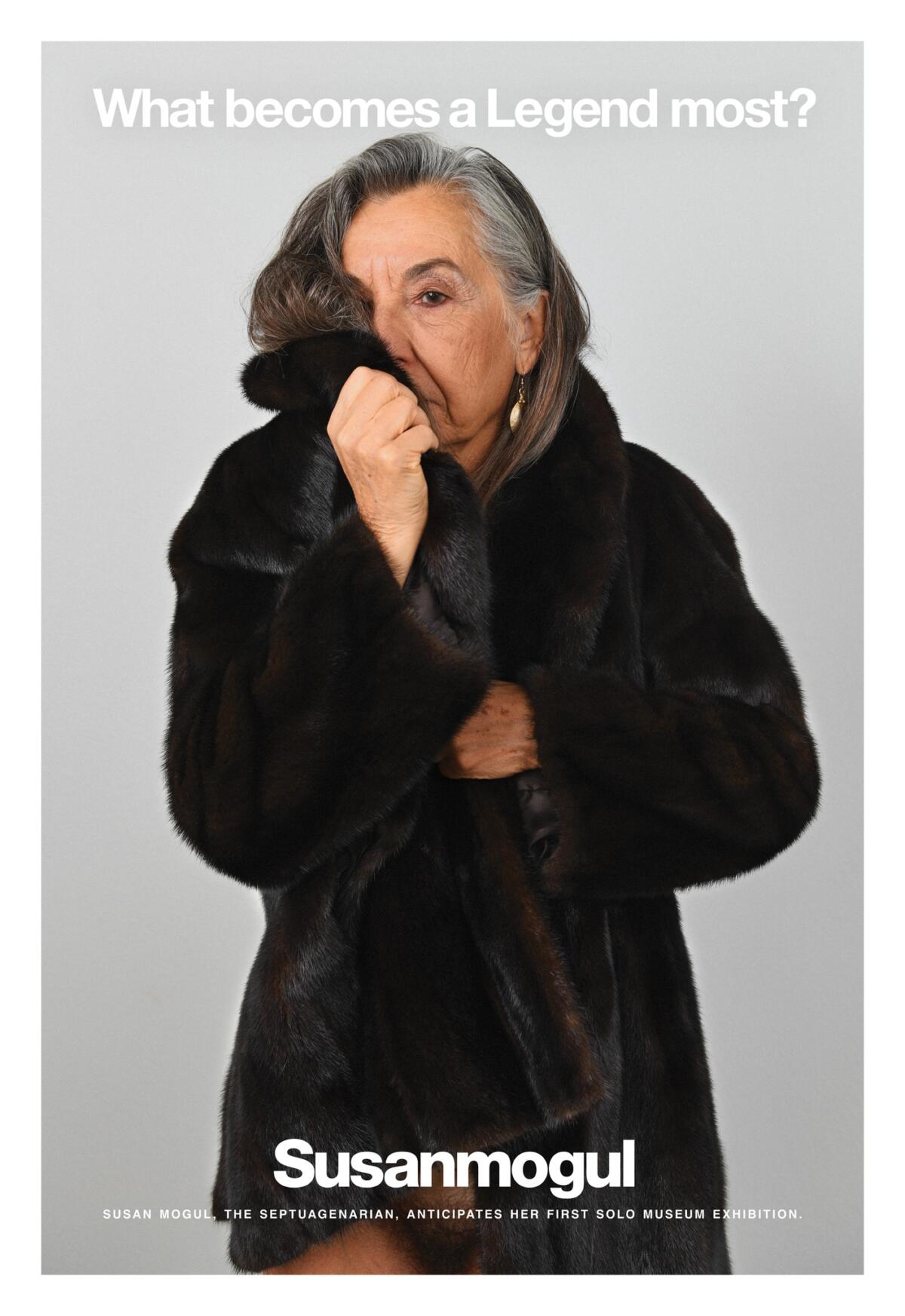
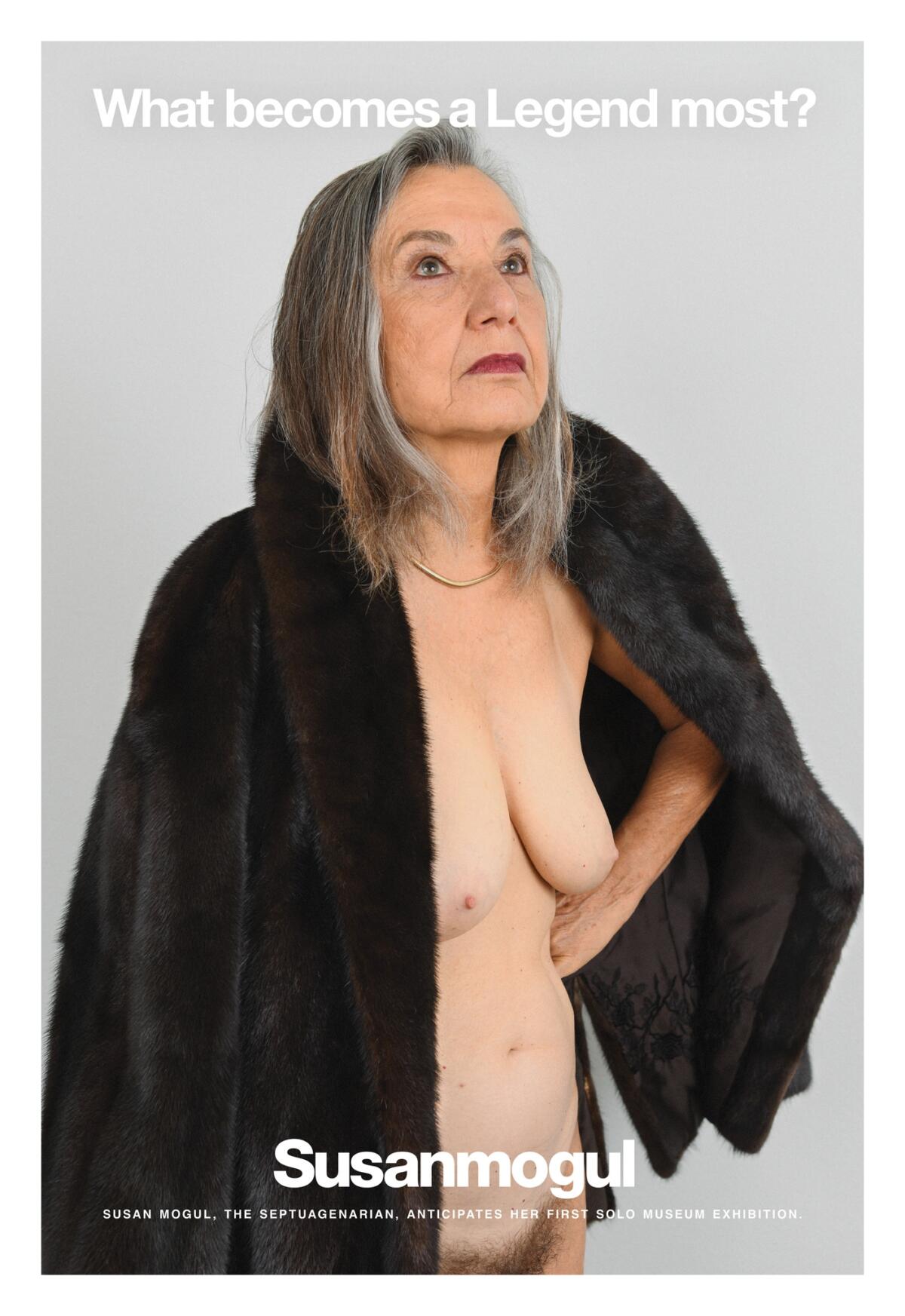
That’s how you got the idea for the work which seems to be the key work for this exhibition?
The story continues. Two years ago an artist friend had dinner with a curator from the Hammer Museum, and somehow my name came up and the curator said: “Susan Mogul, she’s a legend”. And that’s when the idea of using the word legend came to my mind. I was reminded of a famous American mid 20th century advertisement for mink coats, “What Becomes a Legend Most”.
I told my idea to a friend and she responded, “You know, Susan, I have a mink coat I can lend you for the project. It will fit you perfectly”. All the female celebrities in this ad campaign were in their sixties or older. So that’s how my Legend project came about. I didn’t do this piece specifically for the Zachęta exhibition, but when I showed it to Michał Jachuła, the curator, he liked it a lot. And then, he ended up naming the exhibition after the work.
Coming back to your background story, could you tell a bit more about how your professional artistic life looked in between the present moment and the time when you made your iconic works in the seventies?
One of my images, a poster in the Zachęta exhibition, is titled An Artist of a Certain Time (2019). The poster could be described as a satirical resume of my career. It is about making work that doesn’t quite fit into the art world – from the seventies to the present.
You know, I came of age in the 1960s. I protested against the war in Vietnam, fought for black civil rights, gay rights, etc. I was an activist in the feminist art movement in Los Angeles in the 1970s. I have an alternative background and I never thought about getting into a gallery. I was thinking more about creating an alternative environment and building alternative spaces to show work. Living in LA in the seventies was very inexpensive, my artist pals each had their own apartment. Now young people in Los Angeles have to share everything, they have two jobs, everything is so expensive. At that time, if you were a single artist you did not have to be as concerned about money.
I never had the goal to be in the art world in a traditional way. I was making video art, which was outside of the art market. Galleries weren’t buying and selling videos. CalArts was one of the very few schools in the country where people were making videos. There was no formal video art class, because video art was a new medium. So this atmosphere gave me the freedom to be inventive. I was also doing a lot of documentary photography in the seventies and eighties. And gradually my approach to video art and documentary photography merged in the late eighties – early nineties, and I started making diary films. These first person documentaries allowed me to combine biography, autobiography and performance. Making films was a way to develop and expand storytelling. So fitting into the art market never was my goal.
On the other hand, you have works maybe not about the art market itself, but about this will of creating your own artistic name, as the Mogul is Mobil Volume III Redux (1975/2022) for example. From my point of view it resonates with today’s situation, when artists are just creating their names, like brands to sell works and just to fit to the market.
Well, did you know what was on the other side of the Mogul is Mobil postcard? It is an announcement that I finally learned to drive. I decided to “advertise” that I got a driver’s license, which was a big thing for me, because I had been a passenger in a tragic car accident and thought I would never want to be behind the wheel. Mobil was the name of a gas station. But in English, if you add an “e”, it is mobile, which means: moving forward. So that card is basically a celebration of life.
In the seventies, I was very engaged by Sheila de Bretteville’s ideas – she was my primary mentor at the Woman’s Building. Sheila, a graphic designer, was interested in advertising formats. And one of her concepts was to use commercial formats to give women a voice, by injecting our personal and everyday experiences in public spaces. In other words it was a method to give importance to the female experience. So it’s not about career, although I can see how you might see it as being career oriented and branding yourself. I’ve had a couple of recent shows with a Los Angeles gallery and the gallery director has described some of my work as self-promotion – not in a negative way, but as a fact. However, I never saw it that way.

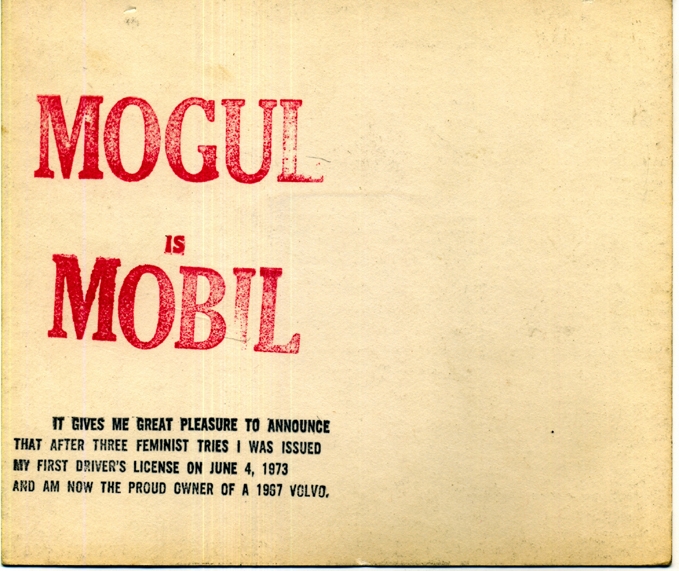
Here in LA, there was a different feminist art movement than the one in New York. We had some different intentions in Los Angeles. Mainly, I think, because the New York feminist artists were more driven to be part of the art market, where in the seventies there wasn’t much of an art market or a museum scene in LA. We didn’t wait to be discovered, we created our own spaces to show our work.
I have another work which you could say is about promoting myself, it’s titled Mogul Celebrates Mogul (2011), you can check it out on my website. When the Getty was doing their citywide exhibition, Pacific Standard Time, about the history of Los Angeles art from 1945 to 1980, two posters were being used to advertise the show. Young male rock stars and actors “celebrated” older male artists, such as John Baldessari and Ed Ruscha. So Mogul Celebrates Mogul poses the question, “Where are the women? Who is celebrating women?” In my poster, Susan Mogul is celebrating herself. It’s a critique. It’s a satire on women being invisible.


You already mentioned the Woman’s Building and its role in your practice. Can you tell a bit more about this place and the ideas behind it?
The Woman’s Building was a non-profit arts and education center located in Los Angeles from 1973 until 1991. I was a member of the Feminist Studio Workshop, an alternative educational program, for women only, located at the building. There was no degree or anything like that. We had an idea of women mentoring other women as well as a do it yourself mindset. I also learned about making work out of your own experience and inserting a personal voice in public places, and, on everyday objects like shopping bags. The feminist art movement here in Los Angeles and the Woman’s Building opened up a space for me to find my own voice. It was a space where you could figure out who you were and what kind of work you wanted to make and be yourself.
We used to do consciousness raising. It was a key part of the women’s movement as well as the feminist art movement, where a small group of women, maybe six or eight, would have a meeting and sit in a circle for, let’s say, an hour. And then you’d have a topic. Let’s say the topic was your relationship to your mother. And then you would divide the time you had, for example, each person gets 5 minutes and nobody is allowed to interrupt you. And it’s the idea that each woman has her own voice and gets to be heard. I tried to use this method and present this idea when I was making my film about the Woman’s Building.

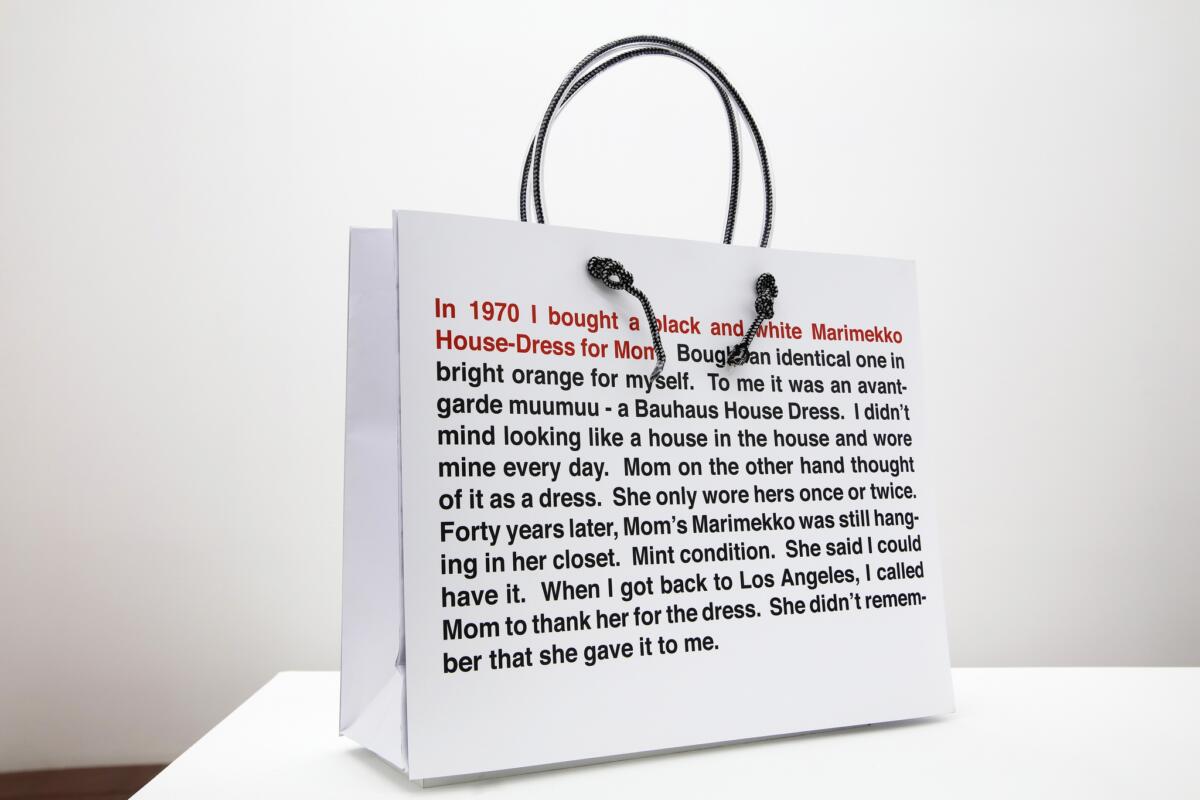
Can we go back to the beginning of your practice? Can you tell a bit more about where your interest in video art comes from?
I was raised in New York. I went to the University of Wisconsin for two years in the Midwest. Then I decided to transfer to art school in Boston where I finished my degree. That’s when I got interested in the women’s movement. I identified as a feminist and an artist, but they were separate identities. I had feminist friends that weren’t at the art school. And then I had my art friends who were not feminists. I was doing different projects in different mediums and I hadn’t found my voice as an artist yet. And then I read about the Feminist Art Program at CalArts in Time magazine and I decided to be part of that. When I got there, my goal was to discover what this whole feminist art thing was. My mentor was Judy Chicago. She brought the women who were in the Feminist Art Program at CalArts to feminist art exhibitions in LA and took us to women artists’ studios. That was her big thing: introducing and connecting women artists, whether you were students or professionals.
At the same time Lynda Benglis, a well-known New York sculptor, came to CalArts for a semester. She was also making video art and she said to me that I should work with video. I have no idea why. CalArts was one of the only schools in the country that had video equipment. You didn’t have to be enrolled in a formal class to borrow the video equipment. That’s when I made Dressing Up, a video about bargain hunting with my mother. I showed Lynda my first version of it, she made some suggestions and I revised it. Then I showed it to my fellow feminists, and to Judy. And everybody thought I was so funny and that the video was good. That was a big surprise. Humor and storytelling. So that’s how that happened.
That’s true, your humor and irony are absolutely unique, and it’s not common for feminist work. Is it a part of your method?
I think it’s part of my personality. When I was 13 or 14 I would make Mother’s Day and birthday cards for my mother. I’m the eldest of six kids. The cards were satirical. I would present mom being torn in 500 different directions by all her children. I always saw my mother as a character. And I also made greeting cards for my great aunt Lea, who I was very close to. They were humorous as well. I was interested in caricature and satire even as a teenager. So that’s part of who I am. In the early seventies there wasn’t a particular way to be a feminist artist. When you’re at the beginning of a movement there aren’t any rules, really. And then when feminist art went into academia – then there were all these rules.
And how were you managing after school? Here in Poland in the 70s some women, after finishing school, didn’t have the possibility to continue to make experimental video because they didn’t have access to equipment. And video was considered a man’s medium. How was it with you?
I never felt any prejudice in terms of like, oh women shouldn’t be making video. A lot of women were making videotapes here. Artists in Los Angeles approached the high cost of equipment in different ways. Some people got together and formed a collective so they could purchase the equipment like we did at the Woman’s Building. There were institutions, for example a University medical school, that allowed some artists to use their equipment when it wasn’t being used. At some point, the Long Beach Museum of Art was giving artists access to video equipment at reduced rates. I didn’t have my own video camera until the late 80s when camcorders were relatively affordable.
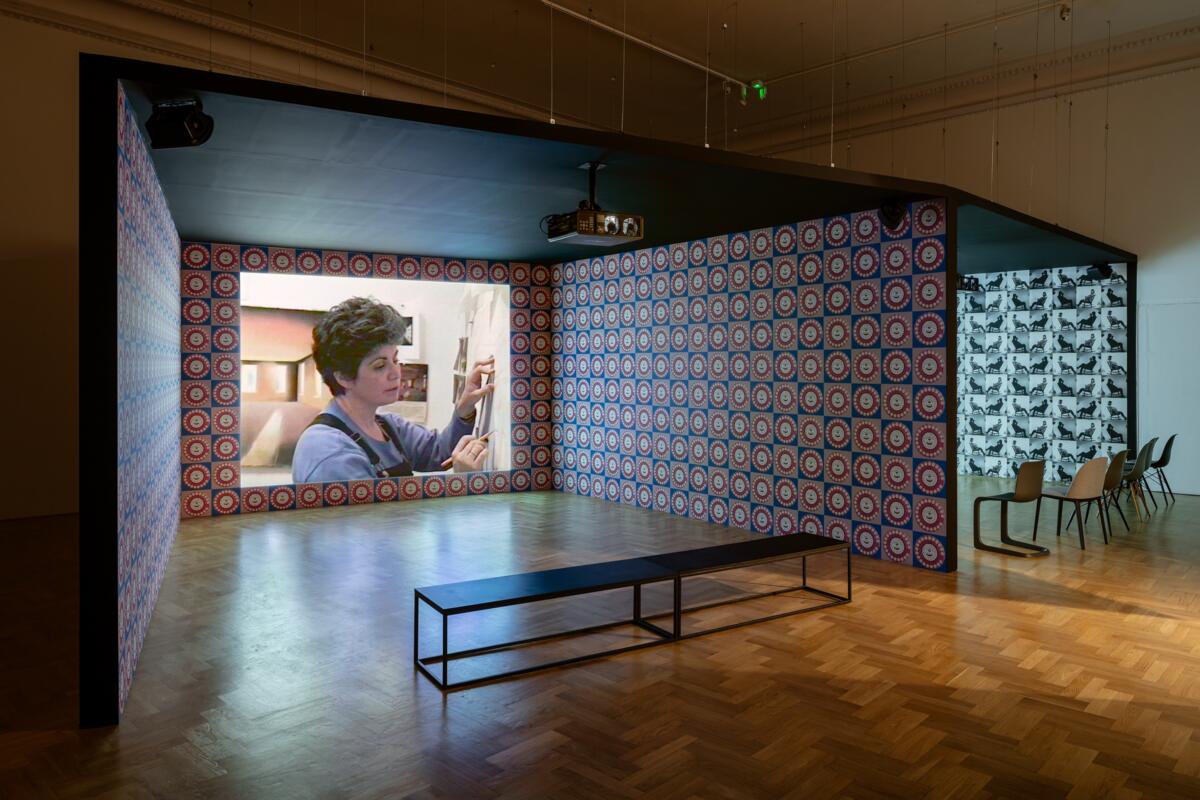
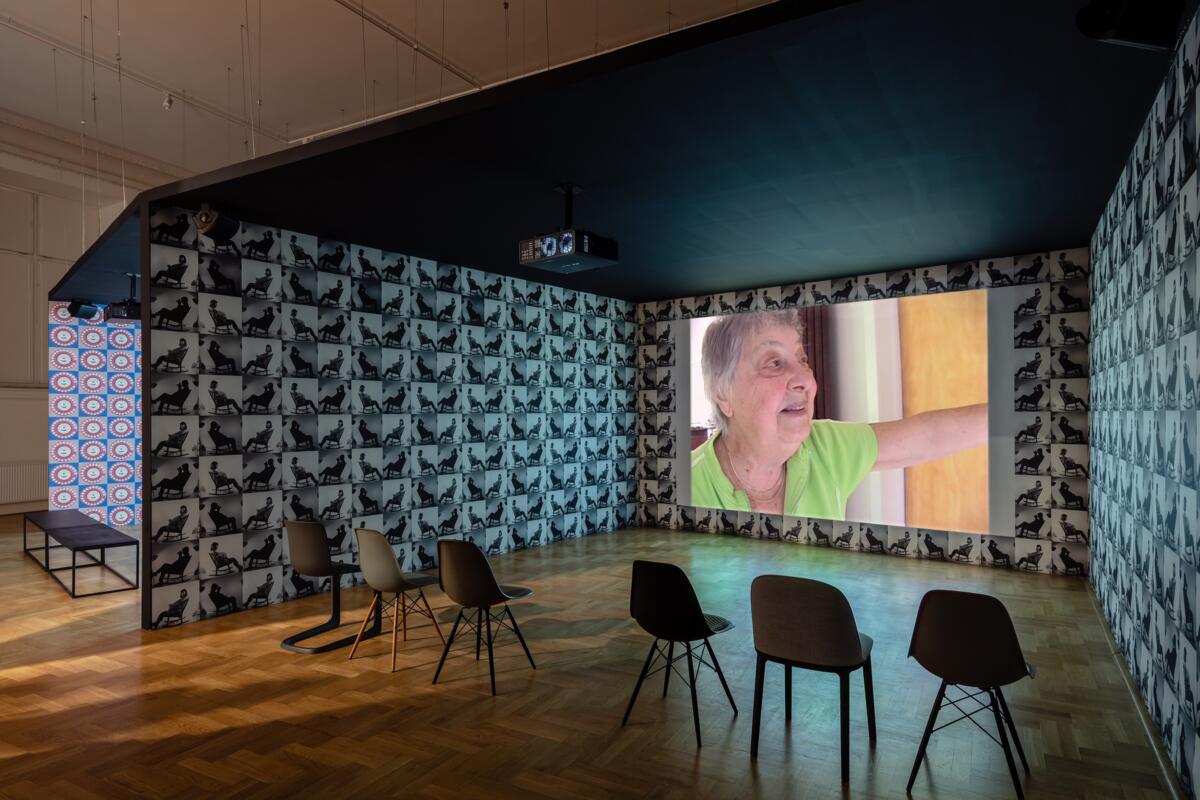
Your mother and the question of maternity plays a huge role in your art. After visiting your exhibition in Zachęta I had an impression that it somehow transmits this idea that if you are a mother, you cannot be an artist or vice versa. Especially because the two films, Mom’s Move (2018) and Sing, O Barren Woman (2000), were shown next to each other. So I’m wondering if these topics (of having/not having children and having/not having an art career) are connected, or was it a coincidence?
Oh, I didn’t think about it that way, but now I understand that you even see it in the wallpaper that frames the two video projection areas. The wallpaper on one projection area has the birth control pill pattern and the pattern on the other projection area is composed of photos of my mom pregnant and me pretending to be pregnant.
What I always felt about my mother is that her photography was always the last thing that she would do. She would work on her projects after everybody was asleep. She stayed up until one or two in the morning, which I mention in the film Mom’s Move. As the eldest child I was aware of all the work involved in raising children. It’s not that I felt burdened, but I don’t think I ever had a burning desire to have a kid on my own. And when I was in my twenties, I was frustrated that my mother always put the family first. That’s how I saw my mother but I don’t think she felt this way. This was my own projection. It was a daughter’s subjective observation. But if I would be honest, I think that to be an artist and a mother is extraordinarily difficult. And even my mother says towards the end of the film Mom’s Move: “You went further than I did”. And maybe that’s what she meant.

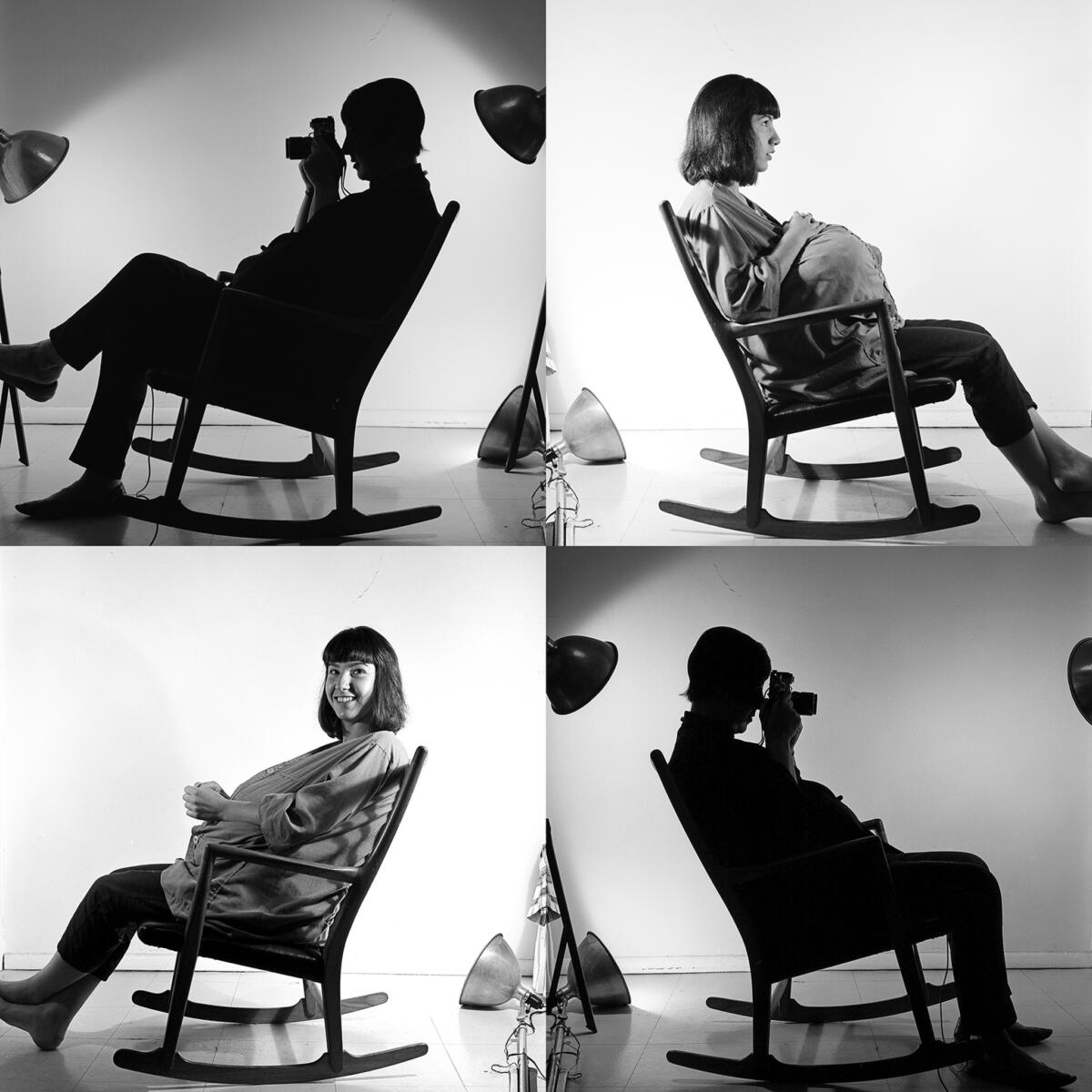
In my opinion you did two things: you made yourself an artist and you made your mother an artist, because you saw her as an artist. And I’m wondering how much her interest influenced your choice to study art and to become an artist?
She clearly had an influence on me, she’s been the topic of a number of works that I made from 1973 to the present. And the exhibition at Zachęta is a culmination or an accumulation of those works. My mother had a very strong personality and she had very definite ways that she dressed, decorated the home, and made photographs. I was engaged with my mother’s work. I would hang out in the darkroom with her, she would show me proof sheets and she often asked me my opinion: which was the best photograph to enlarge, which one should she choose to enter into a competition? I also got used to being a subject of my mother’s work. All of my brothers and sisters were subjects of her work. So I was comfortable being on camera. Mom certainly introduced me to photography. There were many ways I identified with her, but then there were other ways in which I was and am much more radical than my mother. Obviously, a family member or parent can influence your work. But to make the leap to being an artist yourself and making that commitment to be an artist is something different. That I did on my own.
What is the importance of the women in your family beyond your mother?
My maternal great aunt Lea, a milliner, was raised in Riga and emigrated to the United States in 1927 when she was twenty-five years old. Lea was the relative I most identified with – after my mother – because she was independent, creative and childless like myself. Lea studied opera in Paris for two years and lived in Manhattan after she emigrated to the USA. She was the only woman in our family who had her own business and supported herself her entire adult life. Lea was an art lover and was friends with many émigré artists in New York. My mother was also extremely close to Lea. I presented a sequence about Lea in my installation, Tales from the Mogul Archive (2022) at the Zachęta.

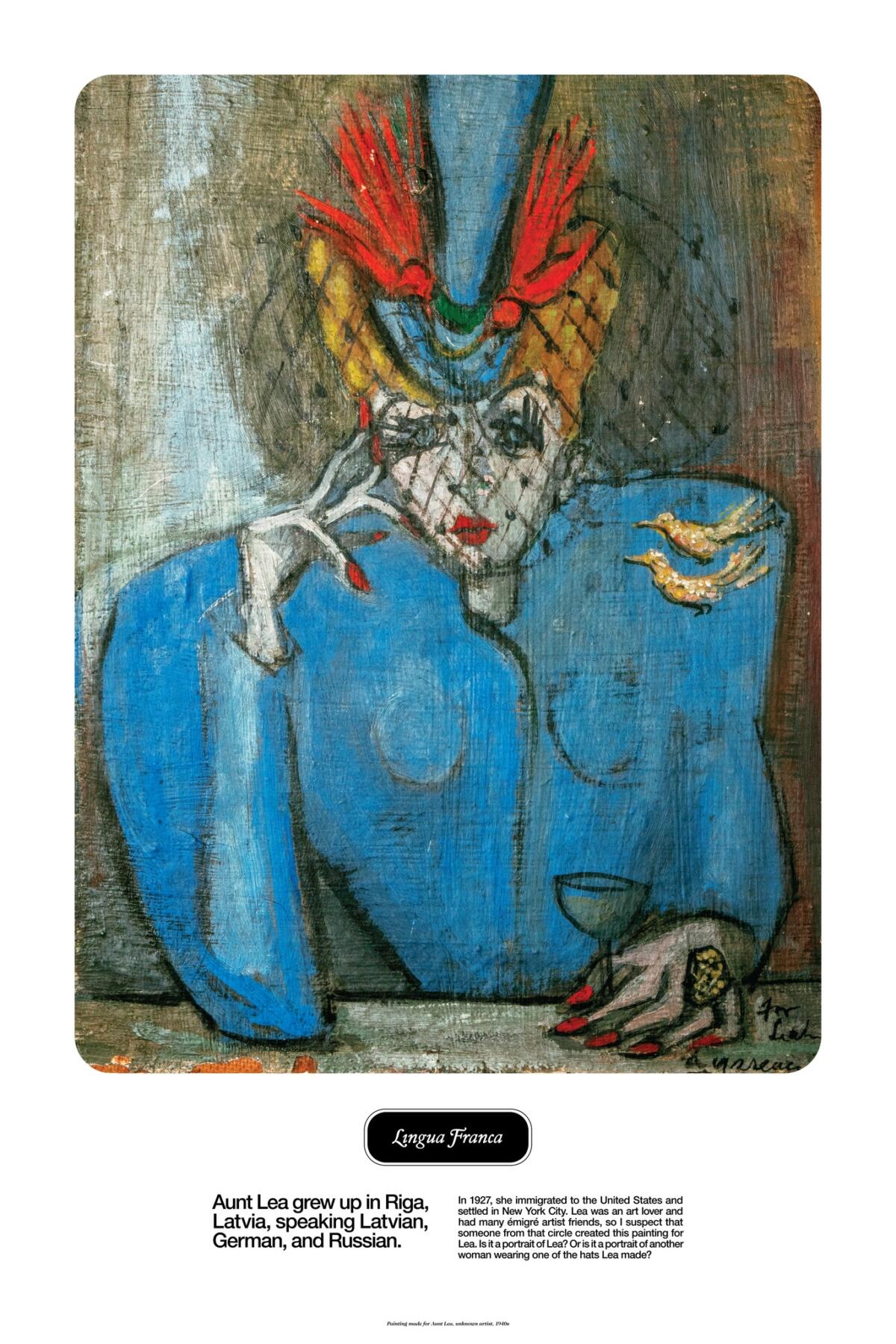
Do you already have some plans for your future work?
Recently I’ve been making contacts with people in Riga because I’m seriously thinking about developing a project about Lea. I have a lot of her documents, photographs, diplomas, citizenship applications and correspondence. I don’t know what I’m going to find, but it will be a continuation of my investigation of matrilineal lineage.
Edited by Ewa Borysiewicz and Katie Zazenski
Imprint
| Artist | Susan Mogul |
| Exhibition | What becomes a Legend most? |
| Place / venue | Zachęta National Gallery of Art in Warsaw, Poland |
| Dates | 05.08 – 30.10.2022 |
| Curated by | Michał Jachuła |
| Website | www.susanmogul.com/ |
| Index | 1970s Judy Chicago Los Angeles Lynda Benglis Michał Jachuła Susan Mogul Vera Zalutskaya Zachęta – National Gallery of Art |

